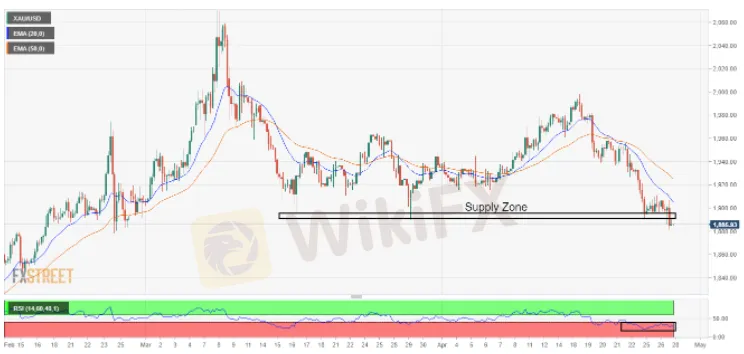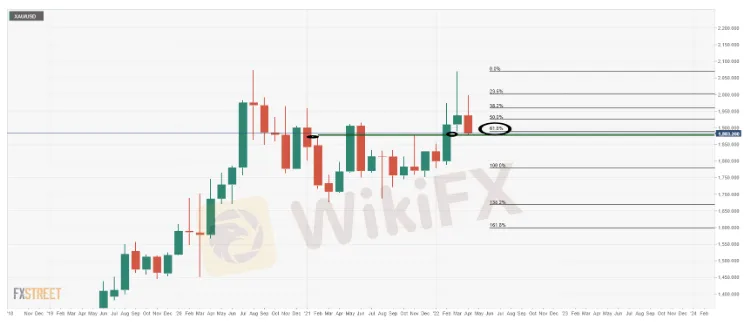简体中文
繁體中文
English
Pусский
日本語
ภาษาไทย
Tiếng Việt
Bahasa Indonesia
Español
हिन्दी
Filippiiniläinen
Français
Deutsch
Português
Türkçe
한국어
العربية
Gold Price Forecast: XAU/USD hangs near two-month low amid broad-based USD strength
Abstract:Gold extended its recent sharp retracement slide from the vicinity of the $2,000 psychological mark and continued losing ground through the early part of trading on Thursday. This marked the second straight day of a negative move - also the fifth in the previous six - and dragged spot prices to the lowest level since February 17. The US dollar index (DXY) is advancing like there is no tomorrow and is now eyeing a move towards the 103.82 area -
Gold dropped to over a two-month low on Thursday amid sustained USD buying.
Aggressive Fed rate hike bets pushed the USD closer to levels last seen in 2002.
Investors now look forward to the US Core PCE and GDP for a fresh impetus.
last seen in late 2002. This turned out to be a key factor exerting downward pressure on the dollar-denominated commodity.
Apart from this, the prospects for a more aggressive policy tightening by the Fed further contributed to driving flows away from the non-yielding gold. In fact, the US central bank is expected to hike interest rates by 50 bps when it meets on May 3-4, and again in June and July, and ultimately lift rates to around 3.0% by the end of the year. The bets were reaffirmed by hawkish comments by various FOMC members, including Fed Chair Jerome Powell last week. This, along with inflation fears, remained supportive of elevated US Treasury bond yields and underpinned the buck.
Meanwhile, analysts at ANZ Bank argued that escalating geopolitical risk and inflation should continue to underpin investment demand. Adding to this, analysts at TD Securities said: while the yellow metal's prices have remained extremely resilient against an aggressively hawkish Fed, as a protracted war in Ukraine simultaneously raised both geopolitical uncertainty and inflation risks and thereby fueled demand for havens, we see few participants left with an appetite to buy gold. The analysts explained that Comex shorts have largely been wiped out, removing some fuel for price strength, while safe-haven flows have a historical tendency to dissipate.
Also read: Gold Futures: Short-term rebound in store?
Going forward, investors are focusing on some potential economic data, which will have a significant impact on the DXY. The US Bureau of Economic Analysis will report the quarterly Core Personal Consumption Expenditure (PCE) on Thursday, which is likely to print at 5.4%, higher than the prior print of 5%. Apart from this, gold prices and the DXY will get impacted by the release of the Gross Domestic Product (GDP) numbers. The annual GDP is seen at 1.1% against the prior print of 6.9% while the quarterly GDP has room for an upside surprise. A preliminary reading for the quarterly GDP is 7.3% in comparison with the previous figure of 7.1%.
Also read: Gold Price Forecast: XAUUSD needs to hold $1,877 to maintain upward bias – Credit Suisse
Gold technical analysis
On a four-hour scale, XAU/USD is facing barricades near the supply zone placed in a narrow range of $1,890.21-1,895.15. The 20- and 50-period Exponential Moving Averages (EMAs) at $1,905.31 and $1,925.57 respectively are heading south, which adds to the downside filters. Meanwhile, the Relative Strength Index (RSI) (14) is oscillating in a bearish range of 20.00-40.00, which signals more pain ahead.
Gold four-hour chart

As for the longer-term charts, the gold price is headed to a potentially strong area of support:

The weekly chart is homing in on prior support and resistance while the monthly chart sees the gold price already meeting the 61.8% golden ratio.


Disclaimer:
The views in this article only represent the author's personal views, and do not constitute investment advice on this platform. This platform does not guarantee the accuracy, completeness and timeliness of the information in the article, and will not be liable for any loss caused by the use of or reliance on the information in the article.
Read more

INFINOX Partners with Acelerador Racing for Porsche Cup Brazil 2025
INFINOX has teamed up with Acelerador Racing, sponsoring an Acelerador Racing car in the Porsche Cup Brazil 2025. This partnership shows INFINOX’s strong support for motorsports, adding to its current sponsorship of the BWT Alpine F1 Team.

The Daily Habits of a Profitable Trader
Every professional trader follows a structured approach to ensure they are well-prepared, disciplined, and able to seize opportunities with confidence. Whether you are a seasoned investor or an aspiring trader, adhering to a robust daily checklist can significantly enhance your performance. Use this checklist to check if you are a qualified trader

The Impact of Interest Rate Decisions on the Forex Market
Interest rate changes determine currency attractiveness, influencing capital flows and exchange rate trends. Understanding this mechanism helps investors navigate the forex market effectively.

How a Housewife Lost RM288,235 in a Facebook Investment Scam
A 47-year-old housewife in Malaysia recently fell victim to an online investment scam, losing a substantial sum of RM288,235 after engaging with a fraudulent scheme advertised on Facebook.
WikiFX Broker
Latest News
TradingView Brings Live Market Charts to Telegram Users with New Mini App
Trump tariffs: How will India navigate a world on the brink of a trade war?
Interactive Brokers Launches Forecast Contracts in Canada for Market Predictions
Authorities Alert: MAS Impersonation Scam Hits Singapore
Stocks fall again as Trump tariff jitters continue
INFINOX Partners with Acelerador Racing for Porsche Cup Brazil 2025
Regulatory Failures Lead to $150,000 Fine for Thurston Springer
April Forex Trends: EUR/USD, GBP/USD, USD/JPY, AUD/USD, USD/CAD Insights
March Oil Production Declines: How Is the Market Reacting?
Georgia Man Charged in Danbury Kidnapping and Crypto Extortion Plot
Currency Calculator







